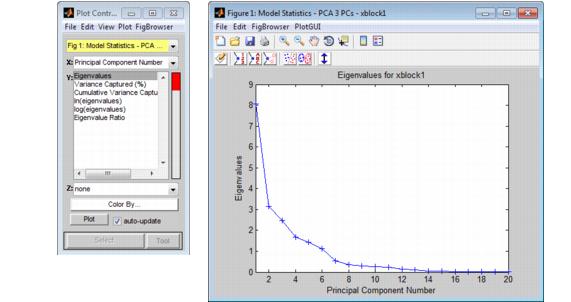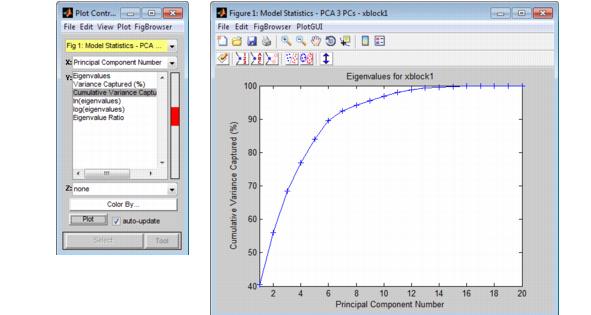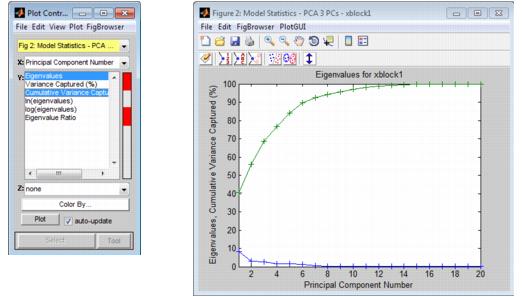Table of Contents | Previous | Next
Plotting Eigenvalues for a Calibration Model
For most analysis methods, the Analysis window toolbar contains a Plot Eigenvalues button  .You use the Plot Eigenvalues option to plot a series of univariate metrics as a function of the number of principal components or factors retained in the model. These values assist you in determining the number of principal components or factors to retain the model and often include the following:
.You use the Plot Eigenvalues option to plot a series of univariate metrics as a function of the number of principal components or factors retained in the model. These values assist you in determining the number of principal components or factors to retain the model and often include the following:
- Variance Captured (%)-The amount of variance captured for each principal component or factor.
|
- Cumulative Variance Captured (%)-The Cumulative Variance Captured (%) value tracks to the % Variance Cumulative column (the last column) in the Variance Captured data table in the Control pane. This plot shows that with an increasing number of principal components or factors, the cumulative variance asymptotically approaches 100%.
|
- The natural log of the eigenvalues.
|
- The log of the eigenvalues.
|
- The ratio of the eigenvalues.
|
- The results from any cross-validation that was carried out.
|
The first figure below shows the plot of eigenvalues as a function of the number of principal components retained in the model for a PCA analysis in which twenty variables were measured and three principal components were retained. The second figure below shows the plot of the cumulative variance captured as a function of the number of principal components retained in the model for a PCA analysis in which twenty variables were measured and three principal components were retained.
- Plot of eigenvalues as a function of the number of principal components retained in the model for a PCA analysis

-
-
-
Note: For information about the Plot Controls window and Plot window, see Plot Controls Window.
- Plot of the cumulative variance captured as a function of the number of principal components retained in the model for a PCA analysis

-
Eigenvalues plot options
You can select multiple Y metrics in the Plot Controls window to overlay these metrics in the Eigenvalues plot. For example, you can CTRL-click Eigenvalues and Cumulative Variance Captured (%) to overlay these values in the Eigenvalues plot.
- Example of Eigenvalues plot with different plot options

-
-
-
-
-
![]() .You use the Plot Eigenvalues option to plot a series of univariate metrics as a function of the number of principal components or factors retained in the model. These values assist you in determining the number of principal components or factors to retain the model and often include the following:
.You use the Plot Eigenvalues option to plot a series of univariate metrics as a function of the number of principal components or factors retained in the model. These values assist you in determining the number of principal components or factors to retain the model and often include the following:


